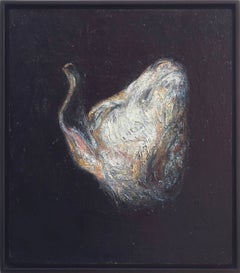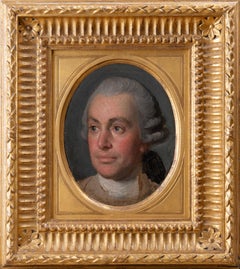Brenda Zlamany Paintings
to
1
1
1
Overall Height
to
Overall Width
to
1
1
1
1
1
12
863
657
650
610
1
1
1
Artist: Brenda Zlamany
Brenda Zlamany, Goat Head #2, 1990, Oil Paint, Panel
By Brenda Zlamany
Located in Darien, CT
The place of the painted portrait in the postphotography, postmodern age is ever-changing. In portrait painting, a connection between the artist and the subject is created by the act of building an image stroke by stroke. This connection is unusual (and perhaps longed for) in a time of virtual reality and high-speed, mediated experience. There is much to be explored in the question of who is portrayed and how.
Brenda Zlamany is interested in the multifaceted nature of portraiture in the digital age. By combining painting, performance, interactivity, photography, a conceptual frame, and a digital presentation, she seeks to challenge schisms in artistic as well as social understanding.
Brenda Zlamany is a painter who lives and works in Brooklyn, NY. Since 1982 her work has appeared in over a dozen solo exhibitions and many group shows in the United States, Europe, and Asia. Museums that have exhibited her work include the Museum of Contemporary Art, Taipei; the National Portrait Gallery of the Smithsonian Institution; the National Museum, Gdansk; and Museum voor Schone Kunsten, Ghent. Her work has been reviewed in Artforum, Art in America, Flash Art, the New Yorker, the New York Times, and elsewhere and is held in the collections of the Cincinnati Art Museum; Deutsche Bank; the Museum of Modern Art, Houston; the Neuberger Museum of Art; the Virginia Museum of Fine Art; and the World Bank. She has received portrait commissions from the World Bank, Memorial Sloan-Kettering Cancer Center, and other institutions. Zlamany has collaborated with authors and editors of the New York Times Magazine on several commissions, including an image of Marian Anderson...
Category
20th Century Symbolist Brenda Zlamany Paintings
Materials
Oil, Panel
Related Items
18th century portrait of the painter Nathaniel Dance
Located in London, GB
Collections:
Robert Gallon (1845-1925);
Private Collection, UK.
Oil on canvas laid down on panel
Framed dimensions: 11.5 x 10 inches
This highly engaging, previously unpublished portrait by Johan...
Category
18th Century Old Masters Brenda Zlamany Paintings
Materials
Oil, Wood Panel, Canvas
The Naiad and the Swan - Painting 19th Century
Located in Saint-Ouen, FR
Albert Auguste FOURIE (1854-1937)
The Naiad And The Swan
Oil on Wood signed low left
New golden and invory stick frame
Dim wood panel : 35 X 27 ...
Category
Late 19th Century Symbolist Brenda Zlamany Paintings
Materials
Oil
H 24.41 in W 17.33 in D 1.58 in
Hans Bertle (1880 1945) Geburt des Todes, 1924 (Cain and Abel) - Symbolist Oil
By Hans Bertle
Located in Meinisberg, CH
Hans Bertle
(Austrian, 1880-1943)
Geburt des Todes - Kain und Abel
(Birth of Death - Cain und Abel)
• Symbolistic painting
• Oil on canvas, ca. 62 x 72 cm
• Original Frame, ca. 87 ...
Category
1920s Symbolist Brenda Zlamany Paintings
Materials
Canvas, Oil
Free Shipping
H 34.26 in W 30.32 in D 1.58 in
Portrait of Gentleman, Thomas Bruce, Earl of Elgin c.1638 Manor House Provenance
Located in London, GB
Titan Fine Art present this picture which formed part of a historic collection of an English aristocratic family, Lord and Lady Sandys at their magnificent baroque and Regency Grade-...
Category
17th Century Old Masters Brenda Zlamany Paintings
Materials
Oil, Wood Panel
H 18.9 in W 16.15 in D 1.58 in
19th Century French Symbolist Oil Painting Sketch of Artists Nude Model Posing
Located in Cirencester, Gloucestershire
The Artists Model
French School, late 19th century
oil on canvas, unframed
canvas: 20 x 17.5 inches
provenance: private collection, France
condition: very good and sound condition
Category
Late 19th Century Symbolist Brenda Zlamany Paintings
Materials
Canvas, Oil
Carina
By Jean-Gabriel Domergue
Located in Paris, FR
Jean-Gabriel Domergue
1889-1962 French
"Carina"
Oil on panel
Signed lower right
Painting : 28 3/4" high x 23 5/8" wide
Frame: 37 3/8" high x 32 1/4" wide
Jean-Gabriel Domerg...
Category
Mid-20th Century Realist Brenda Zlamany Paintings
Materials
Oil, Panel
Ritratto di Nobildonna
Located in Balerna, TI
Santi di Tito
Ritratto di Nobildonna
Olio su tavola, Sec. XVI, cm 74x61; con cornice 116x100x9
Con procedere degli studi su Santi di Tito, del quale è stata recentemente precisata la nascita fiorentina , si viene sempre più definendo come non solo una delle personalità più interessanti della scena artistica fiorentina, ma anche come il più interessante ritrattista cittadino della seconda metà del Cinquecento.
L'attribuzione di questo ritratto al pittore, che nell'impresa dello Studiolo di Francesco I fu uno dei maggiori innovatori fra i giovani riuniti da Vasari e Borghini, appare subito evidente per l’inconfondibile disegno ovale e fermo del volto, reso con un incarnato compatto dai toni rosati che si accende di naturalistiche notazioni epidermiche ma anche di una puntuale figurazioni degli elmenti decorativi dell’abito e dell’acconciatura. Sempre coerente con i modi pittorici di Santi è poi la pittura compatta con la quale vengono definiti i piani semplificati del volto delle donna, che conservano una notazione di luce e di naturale sensibilità in linea con i dettami controriformati dei quali il pittore fu uno dei più fedeli osservanti nella scena fiorentina. Sempre tipica di Santi di Tito è poi la ferma e volumetrica rappresentazione del torso e dell’abito definito nei piccoli intagli della stoffa ma allo stesso tempo semplificato nei volumi delle maniche e del busto. Ancora di santi ci sembra la notazione luministica con la quale è rilevato il disegno dell’abito attraverso stesure compatte ma sottili e trasparenti, oppure è resa la gorgiera bianca che aggiunge una luce netta all’intero dipinto. Una simile scelta pittorica appare nel Ritratto di Guido Guardi coi figli, esposto alla mostra Il Cinquecento a Firenze, (Palazzo Strozzi, 21 settembre 2017 – 21 gennaio 2018, n. IV. 5, pp. 156-157), dove, pur in un ritratto maschile, Santi di Tito usa la medesima cifra formale nella resa dei volti e delle gorgiere.
Pur nell'attenzione alle caratteristiche fisionomiche, Santi di Tito conserva, infatti, una cifra disegnativa sempre evidente e riconoscibile pur col passare degli anni, un carattere stilistico che sostiene, con volumi saldi, ogni sua differente prova pittorica. Ne sono un esempio dipinti quali il Ritratto di donna con Figlia, già in collezione Koelliker2, oppure il Ritratto di Lucrezia (Emilia) e Sinibaldo di Niccol Gaddi3, tutti databili agli anni settanta del Cinquecento proprio per la stereometrica definizione delle forma. Col passare degli anni, invece, tale carattere di ascendenza bronzinesca sembra cedere sempre più in favore di una pittura più morbida e sensibile, chiamata a raggiungere esiti di naturalezza sempre maggiore. Dipinto emblematico per seguire tale percorso rimane il già citato Ritratto di Guido Guardi con i figli , dove Santi di Tito ha effigiato il capofamiglia subito dopo il suo ritorno da Roma, fra il 1564 e il 1568, al tempo in cui il Guardi commission al pittore anche una pala con una Natività per la cappella di famiglia a San Giuseppe. L’uomo, seduto su uno scranno, sembra rimandare per la posa arcaizzante alla ritrattistica di primo Cinquecento, alla quale Santi di Tito s’ispira anche per le pieghe frante ma scultoree dell’abito. Sulla stessa tavola, probabilmente verso la fine degli anni settanta del Cinquecento, il pittore venne chiamato ad aggiungere le effigi di figli, quando probabilmente l’opera era già in cornice, e lo fece con una pittura più svolta e libera, in modo da raggiungere effetti naturalistici di maggiore sensibilità.
Anche nel Ritratto di donna in esame, i volumi saldi e potenti della figura spiccano sul fondo monocromo della parete con un’evidenza che farebbe pensare alle figure eseguite dalla fine degli anni Settanta del Cinquecento, al pari, appunto dei due figli di Guido Guardi.
Nato a Firenze nel 1536, Santi di Tito si form prima da Bastiano da Montecarlo per passare poi dal Bronzino, del quale conserv la preferenza per volumi luminosi e torniti, a cui aggiunse un'attenzione per la chiarezza compositiva e il naturalismo richiesti dai dettami della Controriforma, che lo portarono a guardare allo stile di Scipione Pulzone...
Category
16th Century Italian School Brenda Zlamany Paintings
Materials
Oil, Panel
Ritratto di Gentiluomo con cane
Located in Balerna, TI
Bartolomeo Passerotti ( Bologna 1529 – 3 giugno 1592)
Ritratto di Gentiluomo con cane
Olio su tavola, Sec. XVI, cm 84x69; con cornice 101x87
//
Bartolomeo Passerotti (Bologna 1529...
Category
16th Century Italian School Brenda Zlamany Paintings
Materials
Oil, Panel
Portrait of three children - Bernhard Keil (1624-1687)
Located in Gent, BE
“A portrait of three children, one of them holding a basket of grapes, while another plays the flute”
Oil on canvas
Housed in a blackened 17th-century frame.
We'd like to thank dr...
Category
17th Century Old Masters Brenda Zlamany Paintings
Materials
Oil, Panel
Portrait of a Lady Diana Cecil, Countess of Elgin c.1638, Manor House Provenance
Located in London, GB
Titan Fine Art present this picture which formed part of a historic collection of an English aristocratic family, Lord and Lady Sandys at their magnificent baroque and Regency Grade-...
Category
17th Century Old Masters Brenda Zlamany Paintings
Materials
Oil, Wood Panel
H 18.9 in W 16.15 in D 1.58 in
"Harlequin and his dog", 20th Century oil on cardbard by Ismael de la Serna
By Ismael de la Serna
Located in Madrid, ES
ISMAEL GONZÁLEZ DE LA SERNA
Spanish, 1898 - 1968
HARLEQUIN AND HIS DOG
Signed and dated I. de la Serna, 1955
Oil on cardboard
42 X 27-1/2 i...
Category
1950s Symbolist Brenda Zlamany Paintings
Materials
Cardboard, Oil
Jeune femme à l’éventail (Young Girl with a Fan)
By James Tissot
Located in New Orleans, LA
Conjuring the brilliance of late 18th-century costume with infusions of 19th-century modernity, James Jacques Joseph Tissot’s Jeune femme à l’éventail illustrates the remarkable technique for which he was renowned. His delicate portraiture, combined with his fascination with conveying texture, demonstrates why he was one of the most revered artists of the Belle Époque.
Grouped with Tissot’s “keepsake pictures” of beautiful women in fashionable dress, this work is noteworthy not only for the fresh face of its sitter but also for the appearance of some of Tissot’s most beloved props. The delicate fan and paisley cashmere shawl, a favorite prop of Tissot’s artistic idol Jean Auguste Dominique Ingres, made frequent appearances in his paintings, as did the exquisite dress the sitter wears. Its identifiable styling can be seen in several of Tissot’s most notable works of the period, including La chéminée and Un déjeuner à la riviere.
The playful feel of this painting is grounded by Tissot’s exceptional attention to detail. A master of conjuring an array of textures, Tissot showcased this ability in this composition by juxtaposing many types of fabrics and patterns within one costume. This intricacy, which he carried even to his depiction of the woman’s manicure and jewelry, set him on par with the best artists of his day and contributed to his commercial success.
Born in 1836 in the port town of Nantes, Tissot traveled to Paris at the age of 20 in order to join the studios of Hippolyte Flandrin...
Category
19th Century Realist Brenda Zlamany Paintings
Materials
Panel, Oil
Brenda Zlamany paintings for sale on 1stDibs.
Find a wide variety of authentic Brenda Zlamany paintings available for sale on 1stDibs. You can also browse by medium to find art by Brenda Zlamany in oil paint, paint, panel and more. Not every interior allows for large Brenda Zlamany paintings, so small editions measuring 15 inches across are available. Customers who are interested in this artist might also find the work of Gail Potocki, Marguerite Blasingame, and Jan Frans Deboever. Brenda Zlamany paintings prices can differ depending upon medium, time period and other attributes. On 1stDibs, the price for these items starts at $19,800 and tops out at $19,800, while the average work can sell for $19,800.


